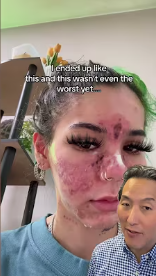
Get rid of bad acne
Get rid of bad acne
Please scroll down to watch the video.👇👇
Getting rid of bad acne (moderate to severe) involves a consistent skincare routine, targeted treatments, and sometimes prescription medications. The right approach depends on the type (inflammatory, cystic, hormonal, etc.) and severity of the acne. Here’s a step-by-step guide backed by dermatologist recommendations and medical references.
🧼 1. Start With a Proper Cleansing Routine
✅ Use a gentle cleanser twice a day:
-
Avoid harsh scrubs that can irritate the skin.
-
Look for products with:
-
Salicylic acid (BHA) – unclogs pores
-
Benzoyl peroxide – kills acne-causing bacteria
-
📖 Reference: American Academy of Dermatology
🧪 2. Use Active Acne Treatments
✅ Over-the-counter treatments:
-
Benzoyl Peroxide (2.5–5%) – Kills P. acnes bacteria
-
Salicylic Acid (0.5–2%) – Exfoliates and prevents clogged pores
-
Adapalene (Differin) – OTC retinoid for deep pore clearing
📖 Reference: Mayo Clinic – Acne Treatments
💊 3. See a Dermatologist for Severe or Resistant Acne
If OTC products aren’t working after 8–12 weeks, seek medical help.
Common prescriptions include:
-
Topical antibiotics: Clindamycin + benzoyl peroxide
-
Oral antibiotics: Doxycycline or minocycline
-
Hormonal therapy:
-
Birth control pills (for women)
-
Spironolactone – reduces androgen-driven oil production
-
-
Isotretinoin (Accutane) – for severe cystic acne
📖 Reference: NIH – Acne Vulgaris Treatment
🧴 4. Moisturize and Protect the Skin
-
Use oil-free, non-comedogenic moisturizers to keep skin balanced.
-
Apply sunscreen daily (SPF 30+); some acne treatments increase sun sensitivity.
📖 Reference: Harvard Health – Acne Myths and Facts
🍽️ 5. Lifestyle & Diet Considerations
-
Limit high glycemic foods (sugar, white bread) – can spike insulin and increase acne.
-
Consider cutting back on dairy, which may affect hormones.
-
Manage stress – cortisol spikes can worsen acne.
📖 Reference: Journal of the American Academy of Dermatology – Diet and Acne
⏳ 6. Be Patient & Consistent
-
Most treatments take 6–12 weeks to show results.
-
Avoid popping or picking – this causes scars and infections.
📌 Summary Checklist
| Step | Action | Product Suggestion |
|---|---|---|
| Cleanse | 2x daily | CeraVe Foaming Cleanser |
| Treat | Benzoyl Peroxide, Adapalene | PanOxyl, Differin |
| Moisturize | Non-comedogenic | Neutrogena Hydro Boost |
| Protect | SPF 30+ sunscreen | EltaMD, La Roche-Posay |
| Consult | Dermatologist | For prescriptions |
Effectively treating severe acne requires a comprehensive approach that combines topical treatments, oral medications, and, in some cases, medical procedures. Here’s an in-depth guide based on current dermatological guidelines and clinical evidence:
🧴 Topical Treatments
Topical therapies are foundational in acne management, especially for mild to moderate cases.
1. Topical Retinoids
-
Examples: Adapalene, Tretinoin, Tazarotene
-
Function: Normalize follicular epithelial desquamation, preventing comedone formation.
-
Usage: Apply once daily, preferably at night, to minimize photosensitivity.
-
Note: May cause initial irritation; start with lower concentrations and increase as tolerated.
2. Benzoyl Peroxide (BPO)
-
Function: Antibacterial agent that reduces Cutibacterium acnes and has comedolytic properties.
-
Usage: Available in concentrations ranging from 2.5% to 10%; higher concentrations may increase irritation without significantly improving efficacy.
-
Combination Therapy: Often combined with topical antibiotics to reduce the risk of antibiotic resistance.
3. Topical Antibiotics
-
Examples: Clindamycin, Erythromycin
-
Function: Reduce C. acnes colonization and inflammation.
-
Usage: Should be used in combination with BPO to prevent resistance.
💊 Oral Medications
For moderate to severe acne, systemic therapies are often necessary.
1. Oral Antibiotics
-
Examples: Doxycycline, Minocycline, Sarecycline
-
Function: Decrease C. acnes and have anti-inflammatory effects.
-
Usage: Recommended for short-term use (3–4 months) to minimize resistance.
-
Combination Therapy: Should be combined with topical BPO.
2. Hormonal Therapies (for females)
-
Combined Oral Contraceptives (COCs): Regulate hormones that can contribute to acne.
-
Spironolactone: An anti-androgen that reduces sebum production.
-
Usage: Particularly effective for hormonal acne, such as that occurring around the jawline.
3. Oral Isotretinoin
-
Function: Reduces sebaceous gland size and sebum production, normalizes desquamation, and has anti-inflammatory properties.
-
Usage: Reserved for severe nodulocystic acne or acne unresponsive to other treatments.
-
Monitoring: Requires regular blood tests and strict pregnancy prevention measures due to teratogenicity.
🩺 Medical Procedures
In-office treatments can provide rapid relief for certain acne lesions.
1. Intralesional Corticosteroid Injections
-
Function: Reduce inflammation in large, painful nodules or cysts.
-
Usage: Provides quick relief and can prevent scarring.
2. Chemical Peels and Laser Therapy
-
Function: Exfoliate the skin and reduce acne lesions and scarring.
-
Usage: Performed by dermatologists; multiple sessions may be required.
🧼 Skincare and Lifestyle Recommendations
-
Gentle Cleansing: Wash the face twice daily with a mild cleanser.
-
Non-Comedogenic Products: Use oil-free and non-comedogenic moisturizers and sunscreens.
-
Avoid Picking: Do not pick or squeeze acne lesions to prevent scarring.
-
Diet: Some studies suggest that low-glycemic diets may help reduce acne severity.
📋 Summary of Treatment Options
| Treatment Type | Examples | Notes |
|---|---|---|
| Topical Retinoids | Adapalene, Tretinoin, Tazarotene | First-line for comedonal acne; use at night |
| Benzoyl Peroxide | Various OTC formulations | Use with topical antibiotics to prevent resistance |
| Oral Antibiotics | Doxycycline, Minocycline | Short-term use; combine with topical BPO |
| Hormonal Therapies | COCs, Spironolactone | Effective for hormonal acne in females |
| Oral Isotretinoin | Accutane | For severe or refractory acne; requires monitoring |
| Medical Procedures | Corticosteroid injections | For large, painful nodules or cysts |
Leave a Reply